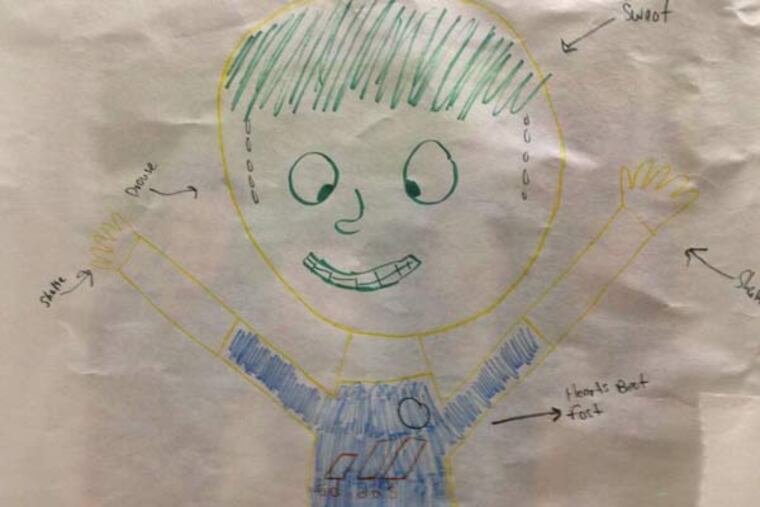Taking a look at anxiety in autism
Some of the autistic children Connor Kerns works with have odd fears: exposed pipes, bubbles on pizza, a microwave's beep.

Some of the autistic children Connor Kerns works with have odd fears: exposed pipes, bubbles on pizza, a microwave's beep.
These may seem innocuous to many people, but for someone with autism, they can trigger a wave of worry and anxiety.
About 40 percent to 60 percent of people with autism have a diagnosable anxiety disorder or an atypical anxiety driven by irregular fears or unusual social anxiety, said Kerns, assistant professor at the A.J. Drexel Autism Institute.
Anxiety is a common concern for the parents of autistic children and adults on the spectrum. But major obstacles have prevented the accurate assessment of anxiety in autism, leaving treatments for this symptom lacking.
For one, most standard anxiety measures are not designed for people with autism, said Kerns. And they can't deal with unusual anxiety symptoms, such as those caused by a minor change in routine.
"A lot of the atypical fears are much more closely intertwined with symptoms of autism itself," she said.
The core characteristics of autism include social and communication impairments and repetitive behaviors. Kerns is developing an autism-specific addition to a standard anxiety assessment.
People with autism may also struggle with assessing their own feelings and thoughts, said Susan White, associate professor of psychology at Virginia Tech. The observations of parents may be unreliable as they have to intuit their children's feelings, said White, who studies anxiety in autism.
Anxiety's role in autism has gained more attention only in the last decade, said Kerns. She blames a tendency among clinicians to focus on the primary diagnosis - autism - and attribute all related symptoms to the disorder.
But among people with autism and their families, anxiety is hard to overlook. This symptom can become increasingly apparent as a person reaches adolescence and adulthood, when the demands of social situations are more complex, said Kerns. In 2020, the number of autistic adults receiving services in Pennsylvania is expected to top 36,000, according to the Pennsylvania Autism Census.
About 20 percent of autistic children and adults in the state have co-occurring anxiety disorders, according to a 2011 state survey. And 20 percent to 50 percent report that their needs for mental health care, including anxiety counseling, are not being met.
In a new study, Philip Kendall at Temple University hopes to better understand anxiety in autistic individuals and improve care. Kendall, director of the Child and Adolescent Anxiety Disorders Clinic, is examining two behavioral treatments, with researchers from UCLA and the University of South Florida.
"It will be the most rigorous examination of the best psychosocial treatment for anxiety in kids on the spectrum that's been conducted to date," said Kerns, a consultant on the study and a former graduate student of Kendall's.
Some participants will undergo standard behavioral therapy for anxiety in children, the Coping Cat program, which Kendall developed 20 years ago. This 16-week program equips children with skills for handling anxiety and recognizing its physical signs, such as sweating and a racing heart.
The program's interactive nature exposes children to typical triggers of their anxiety. They go to stores, interact with new people, and alter routines. "Sitting in a room talking about it is not an option. You have to actually get out there and practice," said Kendall.
Another group will receive a similar program, called BIACA (Behavioral Interventions for Anxiety in Children with Autism), developed at UCLA. BIACA uses the interactive approach of Coping Cat, but is tailored for autistic individuals. Sessions target social skills and include more parent involvement and a prominent reward system, all similar to standard interventions for autism.
Through this study, funded by the National Institute of Child Health and Human Development, Kendall and colleagues hope to learn which treatment more effectively reduces anxiety. The two treatments will also be compared with a control group, in which children will get no behavioral therapy.
But the researchers also want to see whether either intervention can improve symptoms of autism, such as social deficits and repetitive behaviors, which may be linked with anxiety.
The researchers aim to recruit about 200 participants over three years. This large sample will allow them to explore traits that may predict anxiety, especially atypical kinds.
Predicting and treating anxiety will be especially helpful as schoolchildren age out of intensive interventions such as Applied Behavior Analysis.
"This may be kind of the evolution of behavioral treatments that might be really useful for kids on the spectrum as they get older," said Kerns.